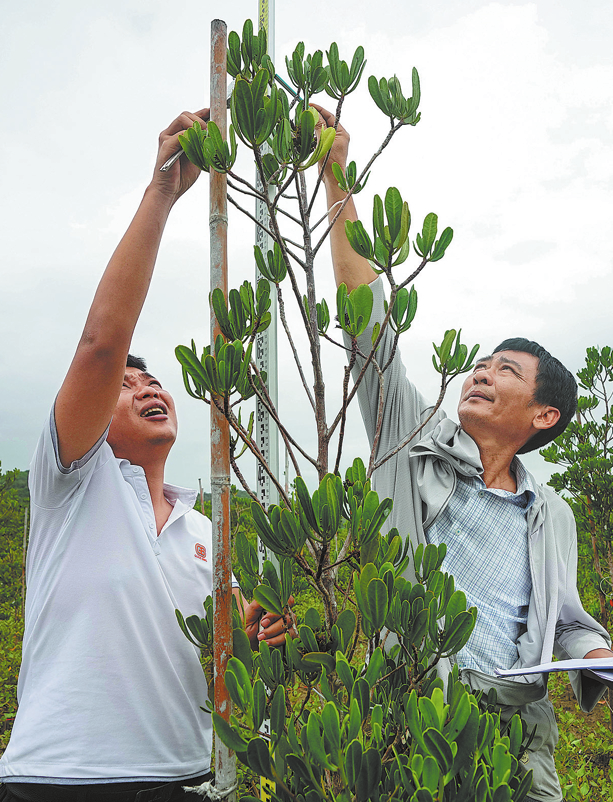
A forestry worker applies botanical healing agent onto an injured red-flowered black mangrove in Tielu port of Sanya, Hainan province, on Sept 5. WANG CHENGLONG/FOR CHINA DAILY
Editor's note: As protection of the planet's flora, fauna and resources becomes increasingly important, China Daily is publishing a series of stories to illustrate the country's commitment to safeguarding the natural world.
When Typhoon Kajiki hit South China's Hainan earlier this year on Aug 24, the island province's coastal regions bore the brunt of the storm's 200-kilometer-per-hour winds.
In the intertidal zones, the red-flowered black mangroves, or Lumnitzera littorea, a species extremely rare in China, faced the tempest. Six of the only 14 existing mother trees in China were damaged in the storm.

Workers hang a nutrient drip bag onto an injured mangrove tree in Tielu port on Sept 9. WANG CHENGLONG/FOR CHINA DAILY
Botanical workers at the port of Tielu in Sanya, where the trees are located, got to work immediately to rescue the trees. What stood in front of them was a mess. Of the six red-flowered black mangrove trees, which were all more than 100 years old and are under first-class national protection, some were snapped in half, others had their main branches broken, and all were suffering from different degrees of decay and hollowing.
"The decay and hollowing are like osteoporosis in humans, letting bacteria and germs enter and leading to holes in the trunk," said Zhang Shijie, a professor of life sciences at Hainan Normal University. He said the lack of timely restoration would worsen the situation and make the trees more vulnerable.

A worker applies healing agents onto the wound of a red-flowered black mangrove mother tree on Sept 9. WANG CHENGLONG/FOR CHINA DAILY
With methods such as filling the trunks with botanical healing agents and supporting racks, forestry workers performed restorations on 13 injured mangrove trees, including the black mangroves.
Based on a report by the China Mangrove Conservation Network, only 14 red-flowered black mangrove mother trees had been identified in the wild as of 2016, including nine at Tielu port and five in Dadun village in Hainan's Lingshui county.

A worker brushes healing agent onto the trunk of an injured tree on Sept 9. WANG CHENGLONG/FOR CHINA DAILY
Zeng Dehua, head of the ecological study center at the Sanya Academy of Forestry, said that no natural germination from the seeds of these mother trees has been recorded since 2015.
Scientists have spared no effort in cracking that bottleneck. Thanks to advances in technologies related to seed cultivation and storage, the artificial germination rate has increased from about 0.3 percent to 6 percent, according to Wang Bingyu, a researcher at the Sanya Academy of Forestry, with some 3,000 saplings expected to be grown within a year.

Workers check the status of an artificially germinated mangrove tree at Tielu port on March 11. The tree was cultivated by researchers three years ago. WANG CHENGLONG/FOR CHINA DAILY

On Sept 5, a worker wraps up the trunk of a red-flowered black mangrove tree to prevent water from entering. WANG CHENGLONG/FOR CHINA DAILY

A researcher checks the status of red-flowered black mangrove tree saplings at a lab at the Sanya Academy of Forestry on Nov 5. WANG CHENGLONG/FOR CHINA DAILY

Forestry worker Wang Shijun checks the third generation of red-flowered black mangrove seedlings at Dongzhai port in Haikou, Hainan, on Aug 2. He introduced the plants from the mother trees in Tielu port in 2013. WANG CHENGLONG/FOR CHINA DAILY
 Editor:Cai Xiaohui
Editor:Cai Xiaohui